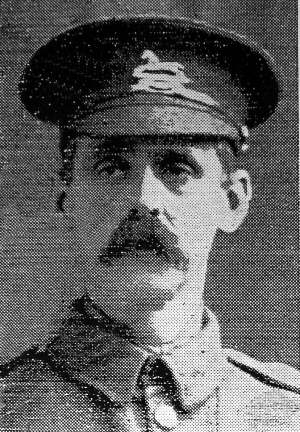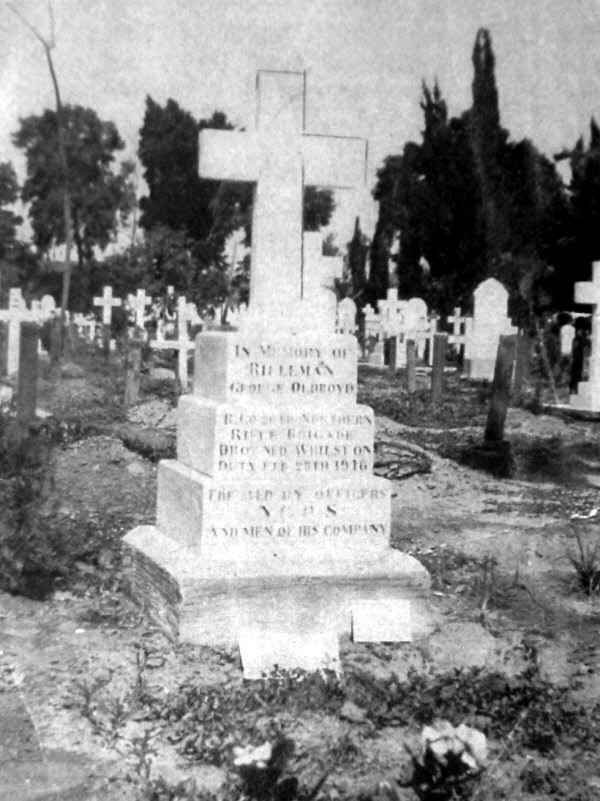
George Oldroyd was born in Ossett in Spring 1871 and was baptised at Ossett Holy Trinity Church on the 4th June 1871. He was the fourth child and third son of seven children born to Joseph Oldroyd and his wife Sophia (nee White) who married at All Saints Church Dewsbury on the 8th November 1866. It was Joseph’s second marriage following the death of his first wife, Elizabeth Hutchinson, in 1862. They had one daughter from their marriage.
In 1871 and 1881 the Oldroyd family were living at Little Town End, Ossett and Joseph was working as a woollen spinner. By 1901 the family had moved to Mirfield and George, now aged 20 was working as a wool extractor. It was here that George Oldroyd met and married Margaret Anne Thomes at St Mary’s Church on the 23rd July 1892. They had two children, born in 1896 and 1899.
By 1911, George Oldroyd, wife Margaret and their two children, Norman, aged 15, and Doris, aged 11, had returned to Ossett where they were living on Woodbine Street. George was working for a woollen manufacturer.
At the age of 44, on the 14th January 1915, George Oldroyd of 31, Woodbine Street, Ossett enlisted at Ossett, in the Territorial Force. He had the option of serving for one year or for the duration of the war. George chose the latter and joined the 5th Battalion, West Yorkshire Regiment. He also had the option to serve only on the British mainland, but waived this right, and pledged to serve in any place outside the United Kingdom should he be so required.
His attestation indicated that he was already in the national reserve and that he had service with the 1st Volunteer Battalion, Kings Own Yorkshire Light Infantry. George was a rag grinder, 5’ 10” tall, weighing 174 lbs, with a chest measurement of 38”. His physical development was described as ‘good’. On the 24th July 1915, he was transferred to the 20th (Northern) Battalion (Territorial), Rifle Brigade (The Prince Consort’s Own), with an army service number of 628. On the 15th November 1915, he was declared fit for service.
George embarked from Liverpool on the 3rd January 1916 and disembarked at Alexandria, Egypt on the 17th January 1916. George Oldroyd was accidentally drowned after falling into a canal whilst stationed at Benha when on duty at Sharkawia Railway Bridge. His body was found in the canal at 6 a.m. on the 28th February 1916, A Court of Inquiry held at Nasria Government Primary School on the 29th February 1916 made the following declaration: “the Court find that No. 628 Rifleman George Oldroyd died from misadventure, and the Court is of the opinion that there is no evidence whatever to suspect foul play.”
George Oldroyd was posthumously awarded the British and Victory medals, and in 1920 these were duly dispatched to his son Norman Oldroyd at 2, Parker’s Buildings, Intake Lane, Ossett. His widow, Margaret was awarded a pension of 15/- a week with effect from the 11th September 1916.
The 20th (Northern) Battalion Territorial Force of the Rifle Brigade was formed on the 28th November 1915 from supernumerary Territorial Force Companies to make Territorial units under direction from the Army Council Instruction as part of Army Order 187. These battalions were used for garrison duty of vulnerable points in Egypt and Palestine.

Above: The grave of Rifleman George Oldroyd at the Cairo War Memorial Cemetery, Egypt.
The “Ossett Observer” 1 had this obituary for George Oldroyd:
“Ossett National Reservist Drowned in Egypt – The sad intelligence has come to hand this week that one of the five Ossett men, members of the National Reserve, who since the beginning of the war have been serving in Egypt with the 20th Northern Battalion Rifle Brigade, has lost his life. The victim is a married man named George Oldroyd, 45 years of age, whose home is at 31, Woodbine-street, off Dewsbury-road, Ossett. He leaves a widow, two daughters and a son, the latter who was 20 years of age yesterday, being at present in training at Salisbury Plain with the second 4th Battalion of the King’s Own Yorkshire Light Infantry.
The information so far available respecting the casualty is of the briefest, but it is from official sources. On Wednesday afternoon, Mrs. Oldroyd received a telegram from the officer commanding the 20th Northern Battalion Rifle Brigade, Egypt saying: ‘Much regret your husband accidentally drowned 28th February. Writing O.C. 20th Northern Battalion Rifle Brigade.’
The deceased, who sixteen years ago was a member of the old Volunteer force, joined the National Reserves, and volunteering for active service, went up for duty a year ago in January, serving at Doncaster and Denham before going to Egypt. He was one of the men who, a few weeks ago, forwarded an interesting letter from Egypt which was published in the ‘Observer’. Other interesting letters have been received from him by his wife and family, the last one being as recent as last Saturday.”
Rifleman George Oldroyd, aged 45 years, son of Joseph and Sophia Oldroyd; husband of the late Margaret Ann Oldroyd of Ossett, died on the 28th February 1916. He is buried at grave reference D. 334 at the Cairo War Memorial Cemetery,2 Cairo, Egypt. This cemetery is within the Old Cairo cemetery area, which is situated approximately 5 kilometres south east of the centre of Cairo.
At the outbreak of the First World War, Cairo was headquarters to the United Kingdom garrison in Egypt. With Alexandria, it became the main hospital centre for Gallipoli in 1915 and later dealt with the sick and wounded from operations in Egypt and Palestine.
General Headquarters, Middle East Command, was set up in Cairo shortly before the Second World War, remaining there throughout the war years. In January 1941, a Royal Air Force Sector Headquarters for Fighter Defence Canal Zone was established. Cairo was again a significant hospital centre during the Second World War.
Cairo War Memorial Cemetery was formerly part of the New British Protestant Cemetery, but plots B, D, F, H, K, M, O, P and Q were ceded to the Commission in 1920. Some graves were brought into these plots from elsewhere in the Protestant cemetery and in 1960, 85 First World War graves were concentrated from Minia War Cemetery, 200 km south of Cairo, where maintenance could not be assured. One burial of the Second World War was also moved later from Old Cairo Old Latin Cemetery for the same reason.
There are now 2,056 Commonwealth casualties of the First World War and 340 from the Second World War buried or commemorated in the cemetery. A small number, known to have been buried in other civil cemeteries in Cairo but whose graves are now lost, are commemorated by special memorial.
References:
1. “Ossett Observer”, 12th March 1916